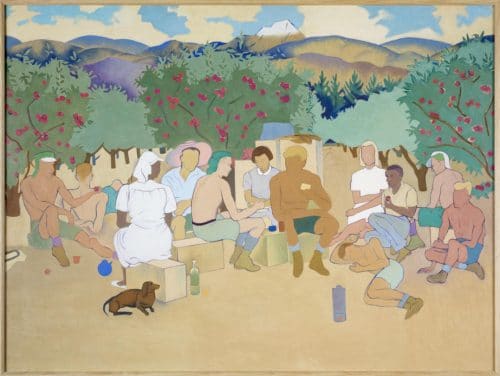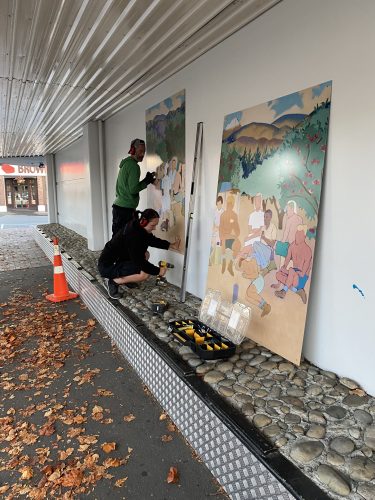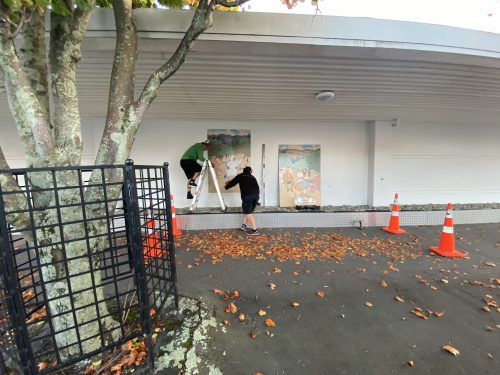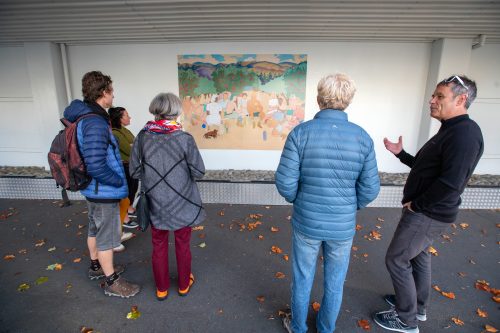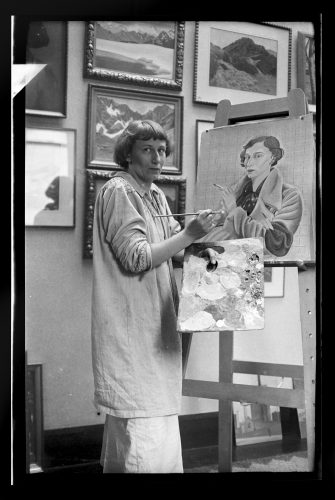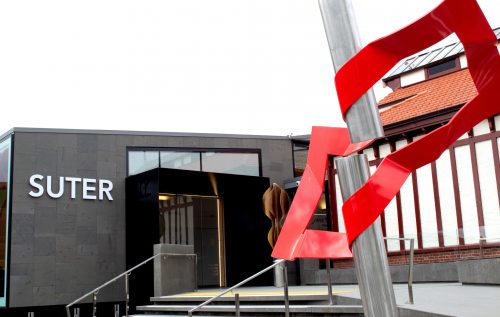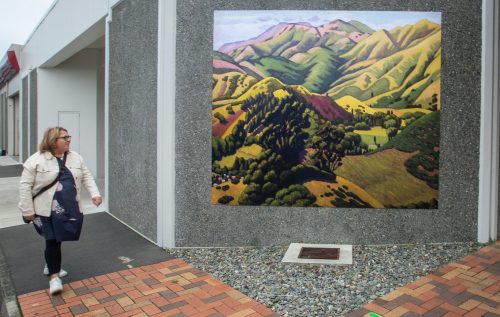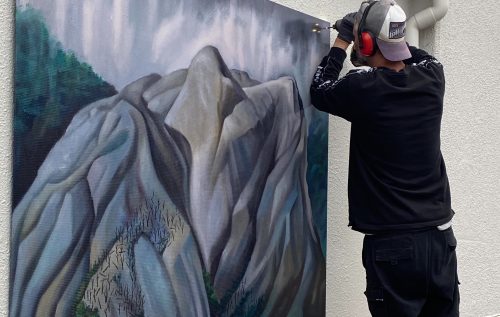Rita Angus painting Self portrait, 1936-1937, by Jean Bertram. Te Papa (CA000242/001/0003)
Significance
The Apples Pickers is significant for its links to the local pipfruit industry, Riverside Community, and migrant seasonal workers.
In 2014, when the artwork came up for sale, the Suter Gallery had just 10 weeks to raise $245,000.
Read about purchase by the Suter Art Gallery’s campaign to buy the work here. And the end result here.
Pip fruit industry
‘The new industry which assures profit, pleasure, health and happiness.’
Arthur McKee, Tasman Orchards Co., 1915
Nelson is the second largest apple growing area in New Zealand, producing predominantly the traditional apple varieties of Cox, Royal Gala and Braeburn.
The first orchard in the region was planted in 1845 in Richmond, with the produce being shipped to the West Coast, as well as across the Tasman. Within a few years, Nelson apples were being shipped as far afield as the UK, where, in 1865, a special prize was awarded to a dish of Nelson apples at England’s Cheltenham Horticultural Exhibition.
It was not until the early 20th century when orchards were planted across Moutere Hills that the region established itself as a major apple-growing region, with the Mapua Wharf shipping about a third of the country’s export fruit. In 1934 the one millionth case of Nelson apples was presented to Lord Ernest Rutherford.
Having the Cawthron Institute in Nelson was a bonus, with their research into pest sprays, orchard management techniques and temperature/humidity control in cool stores. This all culminated in a stable and financially viable apple industry by the late 1940s, leading to a boom in the industry from the 1950s to the 1970s.
From the 1980s, the region has seen significant changes with the introduction of kiwifruit and nashi, the decline and re-establishment of hops, and the substantial investment in grapes. Due to the restructuring of the export market, many of the smaller orchardists left the industry while larger growers actively bought and redeveloped land to achieve economy of scale.
New Zealand produces about 5% of the world’s apples.
Riverside Community
‘If a group of individuals pool their resources, cooperate and live simply, they can create a resource and surplus income to be used for the greater good of society’.
Riverside founders’ basic principle, c1941
Riverside Community is New Zealand’s oldest planned residential community. It was established in 1941 by a small group of Christian Pacifists who were eager to practice ways of communal living, based on cooperation, sustainability, and the repudiation of war. The founders believed equality and social justice to be the main pillars of peace.
One member of the group contributed 30 acres of farmland and orchard in the Lower Moutere Valley, and some of the group moved there to live. Many of the men spent the war years on prison farms as conscientious objectors while their wives and children lived on the community farm. In 1953, the group formed a Trust, which continues to oversee the Community to this day.
Today Riverside’s land is used mainly for dairy (Riverside Milk), tourist accommodation (Hostel, Sojourn), a large venue available for hire, workshops and other events (Riverside Community Cultural Centre), an art gallery (Che Vincent Gallery) as well as a mechanical/engineering workshop (Riverside Workshop) and a joinery. The Riverside Café is a popular spot between Nelson and Motueka.
There are currently around 25 members and their children living at Riverside along regular trust tenants. During busy times of the year when visitors and volunteer workers come to Riverside, the number of people on Trust land can swell up to around 80.
Visit www.riverside.org.nz for more information.
Seasonal workers
Prior the planting of pipfruit orchards, tobacco and hops were a substantial industry in Motueka, Riwaka, Moutere and the Waimea Plains, and set the tradition or bringing seasonal workers into the region. Orchards rely on seasonal workers, and they, in turn, have had an impact on a region’s growth and development.
Throughout the 20th century, the Nelson/Tasman region hosted a diverse range of local, national and international seasonal workers.
Rita Angus
Rita Angus (1908-1970) is one of the leading figures in 20th century New Zealand art. She worked primarily in oil and watercolour, and is well known for her portraits and landscapes.
I, as other painters do, live to paint and paint to live.
Jill Trevelyan wrote an excellent biography, Rita Angus An artist’s life, in 2009, which she revised in 2019. It’sorth listening to an interview with Jill about the biography on RNZ Standing Room Only. The biography is available online at Te Papa.
Te Papa is presenting a major exhibition of Angus’ work, Rita Angus: New Zealand Modernist, opening in December 2021. Scroll down the webpage to see highlights of the exhibition, including Angus 1938 portrait of Leo Bensemann.
As a pioneer of modern painting in New Zealand, Angus evolved a distinctive and highly personal art. She was an austere, disciplined and often exacting woman who was sustained by her belief in her vocation. From the 1960s she was recognised as one of the leading figures in 20th-century New Zealand art.
Henrietta Catherine Angus was born in Hastings in 1908 and spent her childhood between Napier and Palmerston North. In 1927 she began a diploma in fine arts at Canterbury College School of Art, where she received a sound traditional training in life drawing, still life and landscape painting. Touring exhibitions of East Asian art were a source of stimulus, encouraging her growing interest in Far Eastern religion and artistic styles.
Angus married a fellow artist in 1930, but separated four years later and spent most of the rest of her life living alone. During the 1930s and 1940s she had various short-term jobs to eke out a living, and began exhibiting with the Canterbury Society of Arts. Having her painting Cass (of Cass Railway Staion in inland Canterbury) exhibited in the National Centennial Exhibition of New Zealand Art in 1940 signalled the beginning of critical recognition for her work.
However, widespread critical acclaim came relatively late. Interest in her work grew steadily from the late 1950s, due in part to her inclusion in national touring exhibitions organised by Auckland City Art Gallery. Angus continued painting until shortly before her death in 1970, after which her reputation continued to grow. The National Art Gallery’s major exhibition of her work in 1982–83 confirmed Rita Angus’s status as one of the outstanding artists of her generation.
The Group
The Group was an informal but influential art association formed in Christchurch, New Zealand in 1927. Initially begun by ex-students from Canterbury College of Art, its aim was to provide a freer, more experimental alternative to the academic salon painting exhibitions of the Canterbury Society of Arts. The Group exhibited annually for 50 years, from 1927 to 1977, and it was continuously at the forefront of New Zealand art’s avant-garde scene.
Many of the country’s best-known artists were associated at some time with The Group. Among these are Colin McCahon, Doris Lusk, Toss Woollaston, Rita Angus, Leo Bensemann, Philip Trusttum, and Douglas MacDiarmid. The influence of The Group was such that it is occasionally referred to as ‘Bloomsbury South’.
